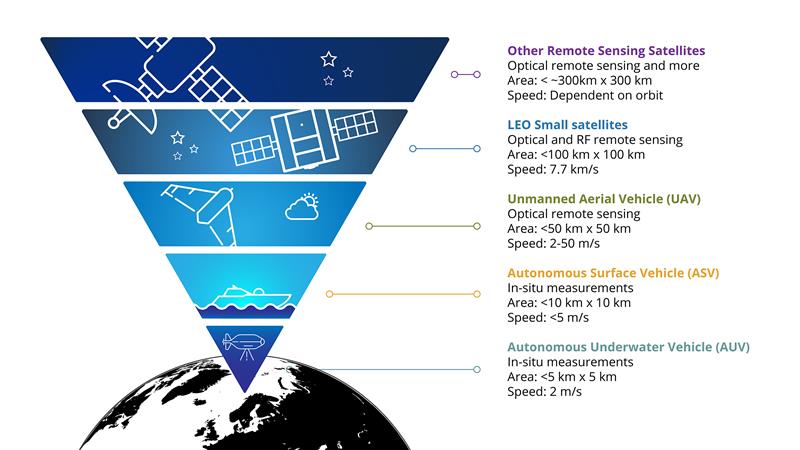Observational Pyramid
The Observational Pyramid: A Collaborative Approach to Ocean Monitoring
The Norwegian University of Science and Technology (NTNU) has developed a novel approach to ocean observation dubbed the observational pyramid. This method utilizes a combination of technologies deployed simultaneously to gather comprehensive data on a specific area.

Observational pyramid (Illustration: Kolbjørn Skarpnes, NTNU).
The pyramid incorporates:
- Small satellites: Like NTNU's HYPSO-1, these satellites capture high-resolution images with hyperspectral imagers, providing detailed information beyond traditional RGB cameras.
- Aerial drones (UAVs): Equipped with hyperspectral imagers, UAVs offer high-resolution data collection at lower altitudes. Learn more about the UAV Lab here.
- Autonomous surface vehicles (USVs): USVs carry sensors that gather data on acoustic properties and conductivity-temperature-depth (CTD) profiles. Learn more about the AUR Lab here.
- Autonomous underwater vehicles (AUVs): AUVs equipped with various sensors navigate underwater, collecting data from different depths. Learn more about the AUR Lab here.
- Ground truthing by biologists: This critical step involves collecting physical water samples to validate and complement the remote data gathered by other platforms.
The observational pyramid's success lies in its collaborative nature. By combining data from these diverse platforms, researchers gain a more holistic understanding of the ocean environment, including potential algal blooms and their impact on the ecosystem. This integrated approach offers significant advantages over traditional methods, allowing for:
- More efficient data collection
- Acquisition of a wider range of data
- Improved understanding of complex oceanographic processes
The observational pyramid holds promise for various applications beyond basic research. Potential uses include:
- Monitoring fish farm health and environmental impact
- Enhancing knowledge of freshwater systems
- Developing automated underwater monitoring systems
This approach is an advancement in ocean observation, with the potential to improve our understanding and management of marine environments.
